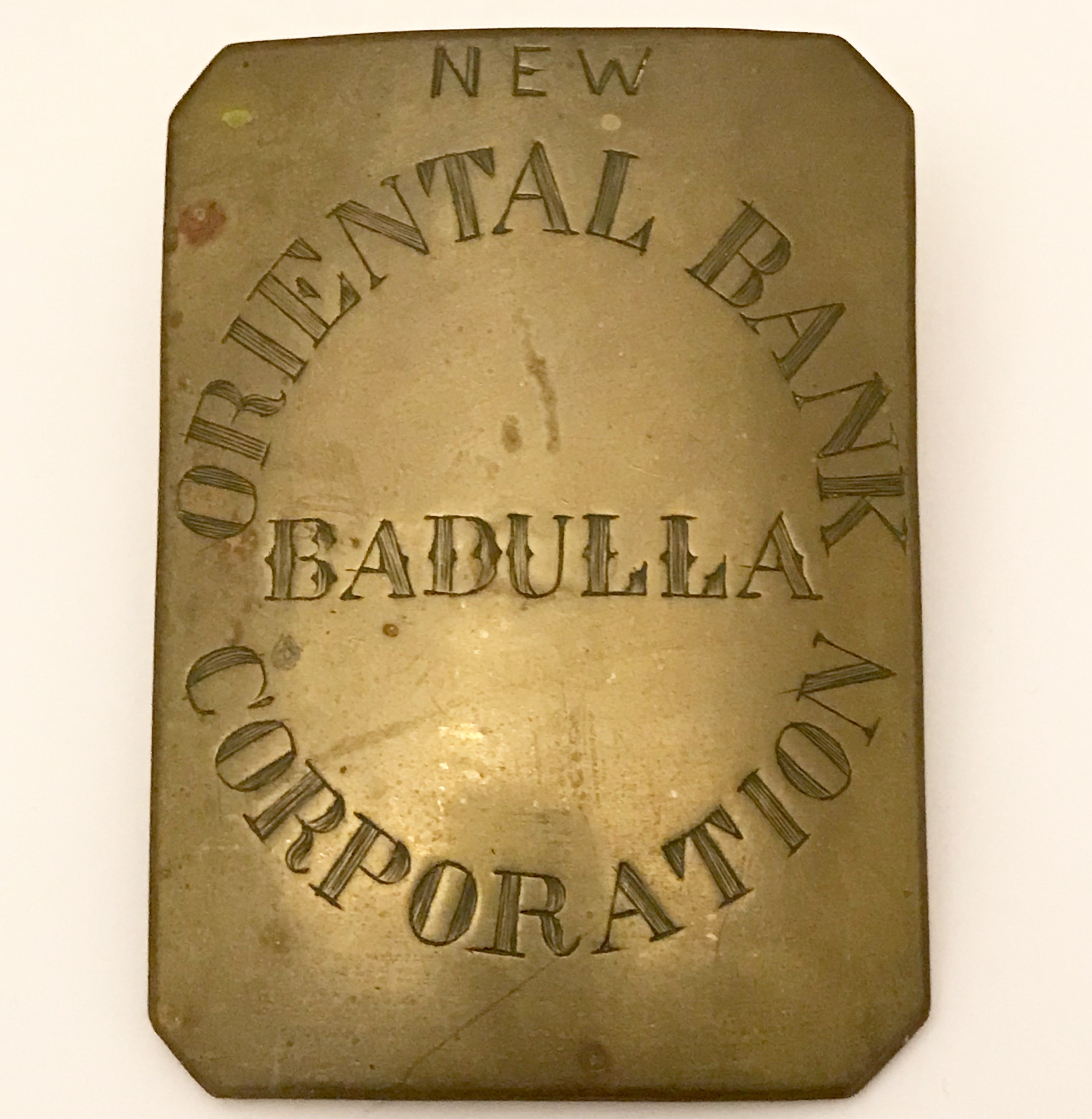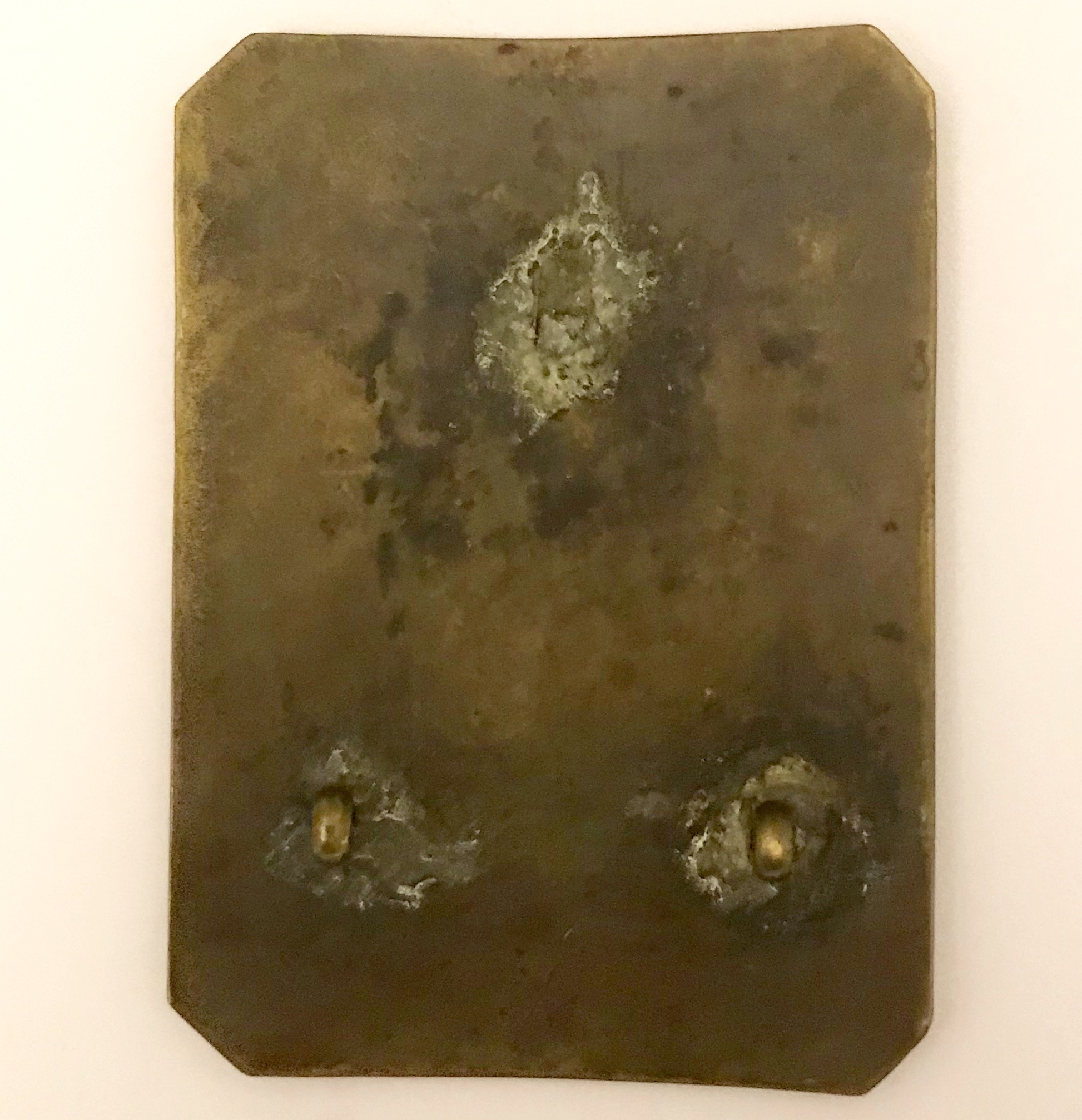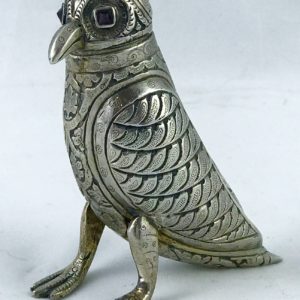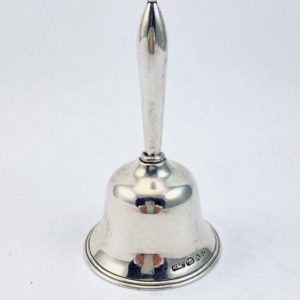Description
A clipped rectangular brass badge-plate (chapras), slightly curved on the vertical axis, with the wording “ORIENTAL BANK CORPORATION” engraved in an oval format surrounding “BADULLA” engraved across the centre and with “NEW” engraved less formally in smaller text at the top. On the reverse (see below), three brass attachment loops were brazed in a triangular arrangement; the top one is now missing.
Dimensions & Weights
Width: 8.3 cm / 3 ¼ in.
Height: 11.4 cm / 4 ½ in.
Further Information
Chaprasi (or Chuprassy)
A Chaprasi is the bearer of a chapras – a badge-plate inscribed with the name of the office to which the bearer is attached. The chaprasi is an office messenger bearing such a badge on a cloth or leather belt. The term belongs to the Bengal Presidency.
The Oriental Bank Corporation: An Ill-Fated Spearhead of International Banking
Overview
The Oriental Bank was the earliest British bank to challenge the East India Company, which had dominated international financial transactions both internally and externally, and it did so successfully, becoming the largest bank in the region. However, after decades of initial success in international banking the Oriental Bank Corporation collapsed through poor investing and violating the rules of its royal charter – a collapse that was both spectacular and a major blow to British banks in Asia. The lessons learnt by British banks from the collapse of the Oriental bank made an important contribution to British banking stability in Asia in subsequent years.
Background
The East India Company’s (EIC) longstanding domination of overseas trade began with the dawn of the 17th century and carried into the late 1800s. By the 19th century the EIC was furnishing the tea trade with illegal opium exports to the East. With this practice unpopular at home in London and abroad, the EIC and its monopoly on foreign trade faced strong opposition from the newly established Bank of Western India, which would eventually form the Oriental Bank Corporation and carve a path for other British banks so successful that they continue to thrive today.
The Bank of Western India opened in Bombay, India in 1842. Its purpose was primarily foreign exchange—a function that the EIC, possessing a royal charter (a document from the monarch granting their discretionary powers to a business entity), could not lawfully partake in. In 1845, the bank took the name of the Oriental Bank, moved its head office to London and set up branches across China, South Africa, Mauritius, Ceylon (taking over the Bank of Ceylon in 1849 with its branch in Badulla) and Hong Kong.
The Oriental Bank changed its strategy by 1850 and began lobbying the British government for a royal charter (albeit the Bank of Ceylon already had one). Although this would put it at direct odds with the EIC’s footholds in the East, the Oriental Bank looked to benefit from the investor confidence that a chartered bank inspired and the ability to take legal action as a corporation.
The EIC pushed back and convinced the government to issue a charter that did not allow banking business in India, but only deposition and payment. As a result, the Oriental Bank changed its name to the Oriental Bank Corporation (OBC) in 1851 and focused on silver holdings, as well as providing loans to coffee plantation owners in Ceylon and sugar cane growers in Mauritius.
The OBC continued to provide a dangerous amount of loans to local growers in spite of the explicit rules against doing so in their royal charter. The depreciation of silver and the bank’s low ratio between issued bills of exchange and loans forced them to further their stake in the East to a point of dependency that was ultimately let down.
As silver’s depreciation worsened, so did the yields in Ceylon and Mauritius. Ceylon’s coffee plantations fell victim to Hemileia vastatrix, the fungus that causes coffee leaf rust disease. Mauritius sugar fell off due to insect infestation in the mid-1860s and many plantations were devastated by a cyclone in 1868. As a result, the plantation owners could not make good on their debts. The OBC failed in 1884.
The New Oriental Bank Corporation was a reconstruction of the OBC and limped through more poor silver prices in the following decade until it too suspended payment in 1892.





